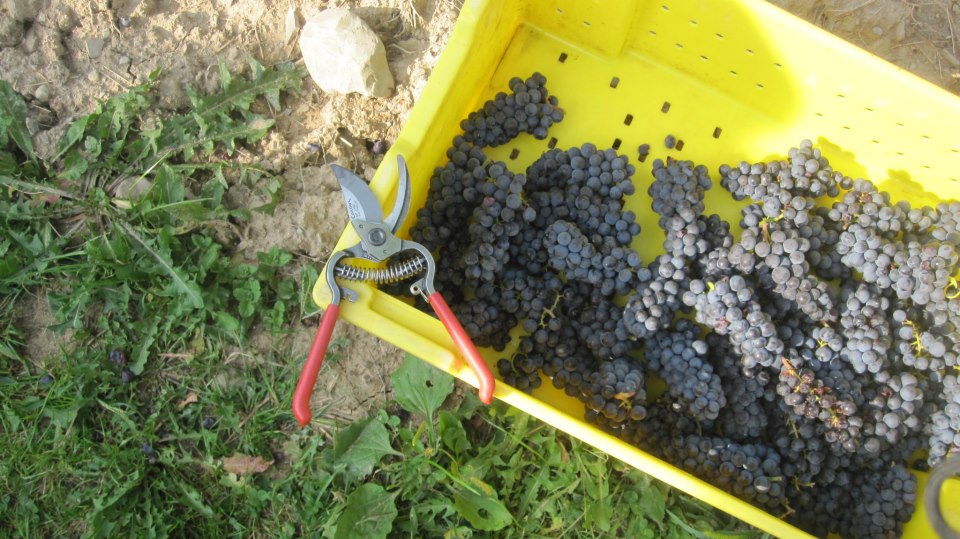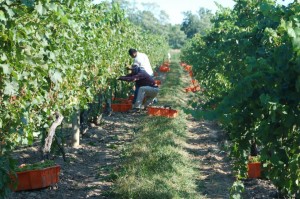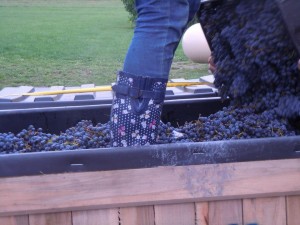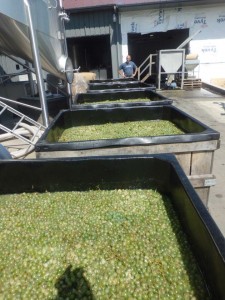
When the wines of 2012 are finally released, consumers will find some of the most complex and deeply flavored wines ever to emerge from the region. Growing practices are better than ever and gradually improving, and the stellar overall weather allowed for more ripening than most varieties enjoy in the Finger Lakes.

If there is one debate, it’s about riesling, which just happens to be the most important variety in the region. There is no question that the rieslings of 2012 will bring less acidity. However, there is reason to believe that this is a feature, not a bug.
One important point must be made: This is not 2007, which turned out to be the worst vintage for riesling in the past decade. Yes, 2012 saw a long, warmer-than-average growing season. Yes, there was a stretch of drought. However, there are several key differences separating 2012 from 2007. First, while the growing season saw a handful of 90+ days, there was not a stretch of 96+ for nearly a week straight. The hottest days were hot, but not consistently near triple digits. Second, more Finger Lakes vineyards are employing irrigation, which mitigated drought factors. For the majority that don’t irrigate, it was stressful, but not deadly. A few vineyards reported a loss of evapotranspiration; in other words, there was fear the the vines were shutting down at one point. It didn’t last.

Now, why is there a difference between 90+ and 96+? The key word is carotenoids. Those are organic pigments in riesling, and when they get too hot and dry during the growing season, the carotenoids can break down prematurely. That typically causes two things to happen: The wines are darker in color, a kind of orangey-yellow. And the wines pick up a whiff of diesel early in their lives, rather than later. In 2007, many Finger Lakes rieslings offered petrol character within the first year of release. Clearly, that was a “drink now” kind of vintage, although happily there are a handful of high-quality exceptions.
So 2012 should not see the rieslings suffer the same kind of early aging breakdown. But what about the acidity?As you’ll see below, there is some disagreement over what that means. But here at NYCR, we often point out that the natural acidity in Finger Lakes riesling can be both blessing and curse. Strong natural acidity is the frame for the wine, and a sturdy frame means a complex wine that can even improve with age. Too much acidity, however, can bring the wine out of balance. This means shrill, sharp wines that we not-so-affectionately describe as “acid water.” The 2012 vintage will allow winemakers to produce dry rieslings with more fruit character than they tend to enjoy.

The richer rieslings should offer more mature fruit. A long growing season affords producers the option of letting flavors develop more deeply. That means evolution beyond the baseline of green apple, lime peel, and slate, and toward something in the range of peach, pear, fennel, apricot, flowers, and spice-tinged dried fruits. And isn’t that more interesting?
On the red wine side, it’s hard to imagine a better vintage in this region. Buds broke remarkably early — six weeks early or more in some spots. There were pockets of frost damage on several occasions, but not enough to destroy the crop in any meaningful way. The dry year meant far less disease pressure than growers saw in 2011. For a while it looked like 2010, another freakishly long growing season, but it ended much stronger. In 2010, heavy September rains threatened to steal some of the richness from the red varieties. In 2012, there was no such problem.Instead of quoting a few producers, we’re doing something a little different. We’re publishing the comments from winemakers/growers/owners in full. This allows you to see how their feelings converge or differ. Yes, professionals are trained to spin. But in this case, it was an undeniably strong growing season. You can see the optimism but also some of the concern about acidity.
Scott Osborn, owner, Fox Run Vineyards:
Without going into much detail it is probably the best fruit we have harvested on all varieties in all the years we have been farming.
Peter Bell, winemaker, Fox Run Vineyards:
I learned some time ago that the aphorism “the proof is in the pudding” is not only nonsensical but a corruption of the real phrase, “the proof of the pudding is in the eating,” which actually makes sense. And so I apply that to the 2012 vintage. Things were touch-and-go during the growing season, starting with a freakishly early budbreak (mid-March, vs the long-term average of early May). The advantage of vines staying dormant, of course, is that they aren’t threatened by spring frosts. This year, a few frost events did happen in late March, but they weren’t serious enough to cause the primary buds much anguish.
Then it stopped raining entirely for us (other sites got more rain) in late June, and we faced what looked like a repeat of the 2011 summer — no evapotranspiration, thus no photosynthesis, thus no ripening. But we were saved by modest rain in early August, and in perhaps the most praiseworthy event, no deluge of rain thereafter.
We picked Chardonnay for sparkling wine on August 26 at 18* Brix, then waited a few weeks before bringing in the rest of the grapes. Many wineries had a very compressed vintage season, with everything coming in in quick succession or simultaneously, but we had good disease and critter control, so could spread things out nicely. Our last grapes (botrytis-affected Riesling) came in exactly 2 months after the first Chardonnay, on October 26th.
Most important, all varieties are of very high quality (contrast this to 2011, when the reds made cheerful enough wine but nothing more). Our reds – Cab, Cab franc, Merlot, Lemberger and PN – are very dense both in color and flavor, and give clear glimpses of the intensely fruit-driven wines they will become. Malolactic fermentation finished in most cases before alcoholic, and we are endeavoring to get the wines into barrel with a little RS left to give them a hint of barrel-fermentation complexity.
Rieslings are as precocious as can be, very exciting to taste, and in need of nothing other than the barest guidance at this point.
So all in all this appears to have been a stellar growing season, and would have been absolutely perfect if we had had irrigation during July.
The proof of the growing season is in the tasting.
Bob Madill, winegrower, Sheldrake Point Vineyards:
- Early spring and a threat of frost that we skated around.
- Overall great weather with low disease pressure yet just enough rain for growth and development.
- Full ripening with a solid crop.
- Early harvest with excellent quality across the board for reds and whites with terrific varietal expression.
- Reds having more color and riper tannins than in many years.
- Riesling with excellent concentration and flavors though not as dramatically racy as some years.
- A wet end for those that may have pushed the envelope.
- Could well be the best since 2001 and 2002 – with both quality and quantity.
For our BLK3 Pinot, an early, warm spring (no frost) and good bud development followed by complete flowering (June 3-5) led to very tight clusters. This also increased yields. The dryness continued and it was necessary to irrigate a little in July. Veraison started early on July 29. Light rain in early Sept promoted swelling, internal berries breaking and some resulting sour rot. Clusters were dropped prior to harvest on Sept 14.
The resulting wine is deeply colored with spicy red fruit, grip and freshness.
Dave Breeden, winemaker, Sheldrake Point Vineyards:
I’m no good at spinning , so I’m just going to tell you what I really think, and do with it what you will. The short version of the story is that it was absolutely a stunning year for everything (but Riesling).
The longer version is that we had really great ripeness in every single thing we harvested (but Riesling). Beautiful chemistry, still great acids, lots of fruit ripeness, and way less disease than we normally see (except in Riesling). See, I told you I wasn’t spinning—I just said we normally have a fair amount of disease! The Pinot Gris came in first, on September 12, at 24 Brix. The last lot of Cab Franc came in last at 23 Brix (except for Riesling for dessert wines, and Cab Franc for ice wine), on 11/9, and that CF was pressed yesterday, so that’s 9 weeks of pressing, which is longer than we’ve ever had.
I’ve pretty much abandoned adding anything but yeast and SO2 anyway (except yeast nutrients), but this is a year that I didn’t wish I could cheat. Pretty much perfect chemistry, all the way around (except for Riesling).
We’ll make a varietal Cab Sauv for the first time in 3 years, and more Meritage than we’ve ever made before. That speaks to the quality of the reds.
So, the Riesling. It, for us, and I surely can’t speak for anyone else in the Finger Lakes, was not our best year for Riesling. Riesling really likes colder years than we’ve had since 2009. That isn’t to say we haven’t made good or even great Rieslings since then, since we have, but we haven’t made Rieslings that I was really, truly excited about, Rieslings out of the norm for good or even great wine. We ended up harvesting all of the Riesling for the Dry and off-dry in the 4 or 5 days before Sandy hit. We had good Brix, upwards of 20, and acids that were find (8.2 for the dry, 9.2 for the semi-dry), and the dry is fermenting along and tasting really nice, but it’s just not quite as exciting as it could be. I suppose it’s mainly about acid—you don’t really get the acids I want, upwards of 10, in years as hot as 2010, 2011, and 2012 have been. The Rieslings will be fine, they’ll be good, maybe even slouching towards great, but they’re not life-changers. We had planned to make s Reserve Riesling, but didn’t have grapes of the quality to do so, and had planned to make a late harvest, but again, don’t have the right conditions to do so.
Art Hunt, owner, Hunt Country Vineyards:
Despite the warm weather in March which pushed the buds, and two months of potential frosts to worry about, most of the vines in the Finger Lakes survived with minimal damage. Thus, the season began much earlier than usual and allowed us to be ahead of schedule all season long. Interestingly, in general, the native varieties were hurt the most by the spring frosts. We generally had half or less of a crop of natives this year. Perhaps this was due to the earlier bud break than the vinifera or French-American varieties. The viniferas and French American varieties had a full crop. Our viniferas actually had the largest crop ever and possibly the best quality as well. The wines are showing nice flavors at this point with no complaints from anyone I’ve spoken to. The grape quality was so uniform at harvest that it was possible to pick many blocks of vinifera by machine without any difference in quality. Most years it pays to hand select the fruit. We still picked nearly all of our viniferas by hand as we preferred the hand selection method.
Marti Macinski, owner/winemaker, Standing Stone Vineyards:
Wow — what a nail biter! From the beginning of March until the end, it was up and down, hot and cold, dry then wet. But, overall, excellent quality of fruit across the board, both white and red varietals. It was tough to get our heads around picking grapes right after Labor Day, but by the time we got to Thanksgiving with all wines finished fermenting, we decided that the early harvest has its advantages. Nothing followed the usual rules: we picked Gewurztraminer before Chardonnay, and Riesling before Merlot. The last few years have taught us well that our biggest strength is to watch, taste, test and constantly be in the vineyard, so that we can find that optimum moment when each variety should be picked. The wines in the tanks and barrels are mellowing out, and we are drawing breath and thinking about next year’s bottling schedule. We are having an event on December 15 and 16 that will help us look closely at the vintage. Our barrel bash will be open barrel tastings on both Saturday and Sunday, on the hour.
Barry Tortolon, winemaker, Rooster Hill Vineyards:
The 2012 harvest at the Rooster went pretty well. We dodged a couple of bullets early on with some spring frosts and came in with an above-average size crop. We source roughly 65% of our fruit from our vineyards here on site and the remainder from about a 15 mile radius of the winery. Although it’s early, the reds are showing well. The Bordeaux reds sourced from our site and Seneca Lake are showing a good depth of structure similiar to the 2007’s. The estate Lemberger seems to be the darkest that I can remember. Malolactic fermentations are done the earliest on record. The Cab Franc and Cab Sauv have been barreled already for a long winter’s nap.
The whites are showing their post-fermentation lull, but the bright aromas and bouquet are coming around. The estate Gewurtz and vidal came in at over 24 brix as did the Sauvignon Blanc. Chardonnay is solid again, with about 50% spending time in new and two year old french and american oak. The three different lots of Riesling are starting to show their personalities based on site and yeast selection.
Tim Moore, owner/winemaker, Inspire Moore Winery & Vineyard:
The quality overall was outstanding. A warmer growing season set the stage for an earlier harvest and what seemed like a much faster pace. We expanded the number of lots of Riesling in production and brought warmer sites in first over an earlier but longer period than last year. Even with warmer temperatures Riesling has great aromatics and intensity. Reds overall look fantastic with great structure and color. For us the 2012 red vintage in the cellar looks more impressive than 2010. Beautiful lots of Blaufränkisch, Cabernet Franc, Merlot and Cabernet Sauvignon.
Jeff Houck, owner/winemaker, Lucas Vineyards:
The reds have better color and concentration of flavors than most years. The structure and tannin are more developed than most years. On the whites, I agree that there is full varietal expression with somewhat softer acidity. Riesling has beautiful aromas and flavors. Given the early challenges I think most winemakers were smiling at the end. (Is there concern about riesling’s acidity?) Not really; the wines have nice balance and might need small adjustments. The whites are showing more tropical notes and less of the citrus notes we see in shorter seasons with cooler temperatures.
Erin Flynn, Marketing Manager, Dr. Frank Vinifera Wine Cellars:
We were blessed during our 50th Anniversary year to have had one of our best harvests ever (certainly the earliest ever as well). In particular, our reds benefited from the longer growing season, enabling their flavors to develop more intensely. Our winemakers are also enthusiastic about the intense flavors and aromas of the whites they have tasted so far. Overall, this should be a great vintage across the board.
Chris Stamp, owner/winemaker, Lakewood Vineyards:
2012 was certainly interesting vintage and it started way before the buds started swelling. After an unusually mild winter, that left vines with little or no cold damage, an unusual and extended warm stretch coaxed the buds from hibernation earlier than ever. It seamed at the time we were doomed to suffer a devastating spring bud kill. Somehow we managed to slip by without any damage, unlike many fruit growers (apples, cherries, peaches) who lost large percentages of their crops. We were very lucky and are extremely grateful. This early start, while nerve wracking, got the whole season rolling weeks ahead of normal and the warm summer did nothing to slow it down. Many varieties were ready three weeks ahead of normal. The vintage was a fun one, with harvest decisions predicated by maturity not disease pressure. On the whole, years like this seem to benefit the reds the most. Cab Franc and Lemberger especially. Both have very dense color and solid ripe tannins. Pinot Noir is interesting. One block I really like while the other block isn’t exactly thrilling me, yet. But Pinot Noir is always trying to mess with my head.As far as the whites go, I find plenty of fruit in all of them. Rieslings are showing a lot of promise. We never see really high sugars in Riesling. We ranged from 19-21.6 Brix this harvest, but the fruit was dead ripe. So our alcohols will only be 10-11.5%, which is where I like them. We didn’t chaptalize any of them, preferring to let the vintage speak more clearly. The acids aren’t as high as they are some years, but still in the window for what we like. We will just make our dry Riesling very close to 0% RS so the acid shows through to the extent that it should. As far as age ability, it’s anyones guess. Sometimes these hot summers make fruit bombs that are show-stoppers until next October, then they just fade away. But pH’s were very low, about 3.00, some even lower. This bodes well for longevity, but is no guarantee. We’ll know more in a couple of years. One thing for sure is, they will be drinking damn good this spring. (I would always rather drink a wine a little too young than too old.)Chardonnay, which usually sees about 20-25% MLF will not see any at all this year so we can maintain our traditional acid balance. Some of the fruit was over 24 brix, and very clean. So there should be a good amount of power to them.
Other exciting wines are Pinot Gris. Beautiful fruit emerging already. More color than usual. I hope a little more drops out soon.
Valvin Muscat: New variety for us this year. Very melony and unmistakably Muscat.
Vignoles: This grape loves this kind of year! Almost 24 Brix at harvest. We stopped it with about 4-5% RS. with perfect acid balance. It’ll be addictive.
Our Baco Noir Vineyard that we use for “Port” came in with record high Brix. 27! It will be very interesting to see how this stuff turns out since we’re breaking new ground with Brix like that.
I’ve probably babbled too long already, but I think you can see, we’re very enthusiastic about this vintage. But at the same time, a little concerned that the wines might be a tad uncharacteristic for the Finger Lakes. More cooler nights in August is all I would change about the ripening season.
